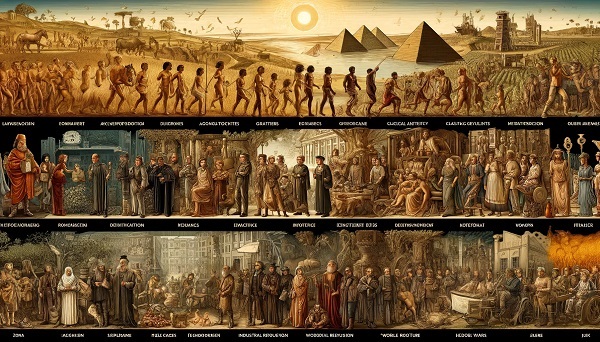
20th Century Art: A Journey Through Time
Gersom
- 0
Introduction
Welcome to the 20th century! This was a time of wild experimentation when artists liberated themselves from the constraints of traditional art and incorporated new styles and techniques, as well as bold new ideas. Come with us as we find out what was going on in the world of 20th century art, discovering its major movements and the artists who defined them.
The Evolution of 20th Century Art
Early 20th Century Movements
Impressionism and Post-Impressionism
At the end of the preceding century, Impressionism had broken new ground with its distinctive treatment of light and color. Post-Impressionists such as Vincent van Gogh and Paul Cézanne would take these ideas even further, but the artistic horizon that was to be acquired with such intensity and originality was already glimpsed.
Key Artists and Works
One swirling sky above ‘Starry Night’ (1889) by Vincent van Gogh, and one fragmented form across ‘Mont Sainte-Victoire’ (1904-06) by Paul Cézanne. Photo courtesy National Gallery of ArtIn juxtaposition, the two ideas provide enduring insights into a significant era of art-making. Van Gogh’s swirling skies were not merely paintings of galaxies or the seasonal stars. His magnificent artwork both expressed the personal emotion of a man who was in anguish, and also pointed the way to the avant-garde movements that would take art to new directions in the early part of the new century. Similarly, we can view Cézanne’s fragments as more than an artist’s interpretation of a sun-baked rock wall before him. There is a personal expressivity in his artworks that also serves as an ideal blueprint for the successors of this style.
Fauvism
The Fauves, or ‘wild beasts’, hit the scene with pure color and emotional intensity. Led by Henri Matisse, they abandoned reflection on the real world in order to reveal more about their own minds and feelings by using pure, full-blown hues.
Key Characteristics
Fauvism = fireworks colors: Wild, unrestrained and mercurial, it’s the art world’s answer to the spectacle of the Fourth of July.
Notable Fauvist Artists
Besides Matisse, André Derain and Maurice de Vlaminck were equally prominent, each stamping his own personality on the Fauvist palette.
Cubism
Cubism, one of the most radical art movements of the early 20th century and the one that likely came closest to inventing collage, smashed the different views of an object into geometric shapes that could all occupy the same space. Pioneered by Pablo Picasso and Georges Braque, it veered indecisively between ‘analytic’ and ‘synthetic’ stages, depending on whether objects in paintings were reduced to the flat planes that composed them (analytic) or constructed three-dimensionally out of them (synthetic). One thing was very clear, though: it dispensed entirely with the convention of ‘correct’ shading.
Origins and Development
Informed by Cézanne’s geometric simplifications, Cubism introduced an entirely new way of looking, not so much a conventional representation of things but the reinvention of things viewed simultaneously from various perspectives.
Pioneers of Cubism
Picasso’s Les Demoiselles d’Avignon (1907) and Braque’s Violin and Candlestick (1910) – both fragmented, abstracted and absolutely revolutionary – come to mind.
Mid 20th Century Movements
Surrealism
Surrealism is an episode in the history of the unconscious, one that makes dreams and reality flow together. It was more than just an artistic movement – it was an approach to thinking and seeing the world in a new way.
Dreams and Reality
Surrealist works have a dreamlike feeling – eerie, fantastical, otherworldly. Not quite nightmares, more like night journeys. They demand and reward adventurous imaginings.
Salvador Dalí and André Breton
Dalí’s melting clocks had appeared in his painting The Persistence of Memory (1931), and Breton’s nihilistic Surrealist Manifestoes had provided a blueprint for the Surrealists’ investigation of the subconscious, as well as a way to dramatize it.
Abstract Expressionism
Following the Second World War, American art produced Abstract Expressionism, inspired by a heavy aesthetic and highly expressive, almost rhapsodic style, and was characterized by ‘automatic’ or ‘subconscious’ creation.
Action Painting vs. Color Field Painting
Abstract Expressionism split into two streams: Action Painting, like Jackson Pollock’s wild drips, and Color Field Painting, such as Mark Rothko’s calm blocks of color.
Jackson Pollock and Mark Rothko
Pollock’s frenetic No. 5, 1948 stands in stark contrast to Rothko’s contemplative No. 61 (Rust and Blue). Abstract Expressionism accommodates extremes, not least of all within itself.
Late 20th Century Movements
Pop Art
Pop Art, at the end of the 20th century, took the denizens of popular culture and transformed them into high art, in a cheeky, sarcastic comment on consumer culture and mass media.
Everyday Objects as Art
Pop Art rejects elevated, heroic sentiments in favor of the ‘vulgar’ image; soup cans, comic strips and celebrities, jolted stark through color and form.
Andy Warhol and Roy Lichtenstein
Along with Warhol’s Campbell’s Soup Cans (1962) and Roy Lichtenstein’s paintings of comic-book panels, it paved the way for a new democratic, avant-garde tradition of humor.
Minimalism
Minimalism reduced art to its basic essence, down to pure shapes and essences: ‘less is more’, the creed went, ‘less is more’.
Less is More
Minimalist works tend to be sparse, easily constructible geometries that use the simplicity of spaces and the oppressiveness of surfaces to idealize minimalism.
Key Minimalist Artists
Minimalist artists such as Donald Judd and Agnes Martin with their flat geometries, pure colors and uncluttered lines represented a form of calm – a cool modernist refuge from the tensions of an urban, media-saturated society.
Impact and Legacy
Influence on Contemporary Art
The ilmāt of the 20th century: The 20th century movements – Impressionism, Symbolism, Cubism, Futurism, Dadaism, Surrealism, Expressionism, Fauvism, and Pop – have been a huge influence on the art of our time. The artists of today are still building on innovation of their predecessors, using old and new forms within exciting combinations.
Global Reach and Cultural Impact
Western art of the 20th century was not solely a Western phenomenon; its transformations have been felt throughout the art world, as artists across the globe took heed, in their openly admitted admiration and significant borrowings from ‘Western art’. This is not to ignore the parochial imaginings that are still at work in today’s art marketplace, with their forces of self-exclusion. Nor does it disregard Western imperialism’s devastating effects on all levels – cultural, political, economic, environmental. But it is to recognize that the era of globalized art, so often reminisced over in nostalgic surveys of modernity, was happening across the globe, with surprising interconnections, deep cross-currents of creativity, and far more sympathetic states than we could have ever imagined.
Conclusion
There was nonstop productive change in art during the 20th century: from the bright shocks of Fauvism to the sparse daring of Minimalism, this was a century of artists making up new rules as they created new works of art. Now that we’re living in the 21st century, we can recognize all the monumental experimentation and damning creativity that made the preceding 100 years such an exciting time for artistic output.
FAQs
What defines 20th century art?
Art in the 20th century was largely characterized by its diversity and experimentation. We can identify a variety of art movements ranging from Fauvism, Cubism and Surrealism in the early part of the century to Abstract Expressionism, Pop Art and Minimalism in the latter part.
Who are some key artists from the 20th century?
Pablo Picasso, Henri Matisse, Salvador Dalí, Jackson Pollock, Andy Warhol, Mark Rothko and other pivotal artists of the movement.
How did 20th century art influence contemporary art?
These techniques, perspectives and concepts, often pioneered by painters of the 20th century, are still found in the work of artists today. The legacy of 20th-century art is the enormous range of current practices.
What is the significance of Pop Art?
Pop Art incorporated elements of commerce and popular culture: it collapsed the boundaries between high and low art; between the spectacle of art and the banality of the post-medieval consumer; and between the sanctity of the gallery and the billboard. Art had always been inspired by everyday life but with Pop Art, art became more prosaic in subject matter and more populist in presentation. Pop Art democratized art because it could make a fetish out of anything at all: soap advertisements, repeated portraits of Marilyn Monroe, photographs of tv dinners.
How did Minimalism change the art world?
Minimalism’s underlying principles of purity of form and simplicity – the pared-down presentation of the essentials – went on to inform a huge number of strands in the world of design, from clothes and furniture to architecture. It was directly opposed to the complexity of other currents of thought, and offered compositions that seemed almost stark.
LG G8 ThinQ iPhone 12 Pro Max LG V60 ThinQ iPhone XR Samsung Galaxy Z Fold2 LG K40 LG G8 ThinQ LG Velvet Samsung Galaxy S21 Samsung Galaxy Z Fold2


